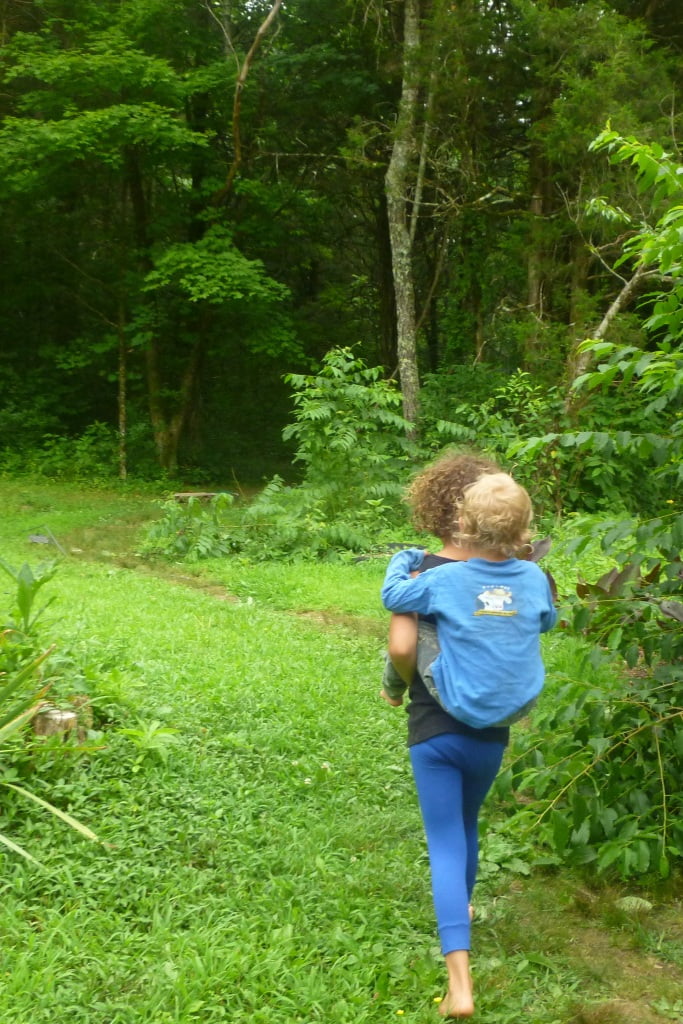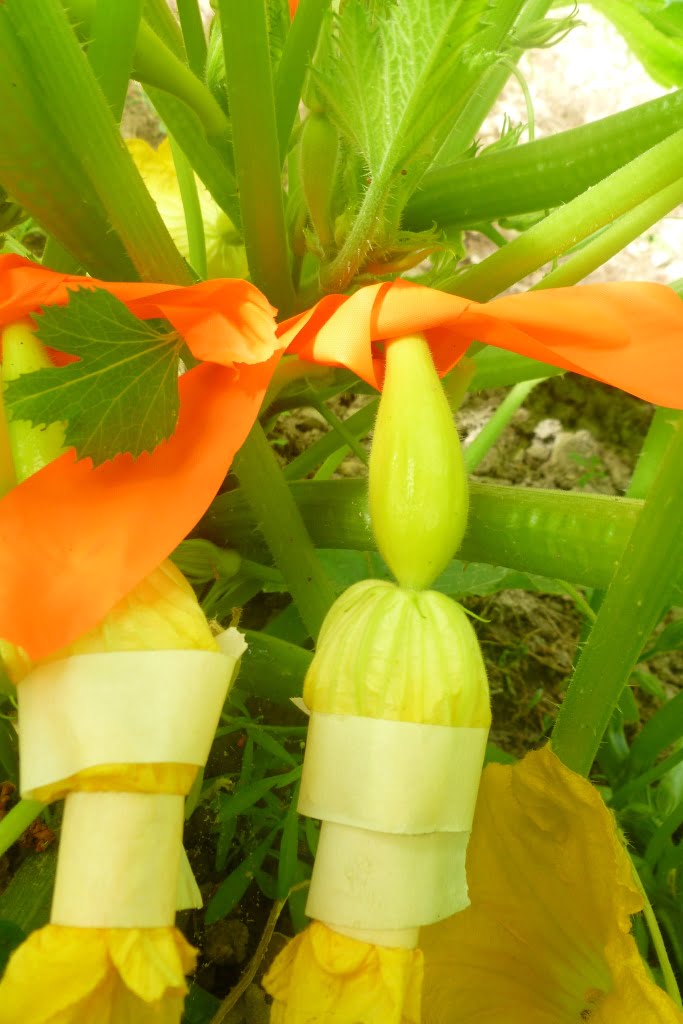quality time
Lately at our house Time has been the final frontier. We’re feeling its elasticity. Sometimes it snaps us around, sometimes it stretches us out. Summer squash and green beans ripen as we watch and want to be picked every hour. Peaches go from perfectly ripe to messy mush in less than a day. Then there are the (many) long term projects. We don’t just think ahead, we work ahead, laboring for distant futures whose very reality hang in the balance of our activities today.
Seed saving projects are among our favorites of this nature. We save everything we can. The first season we were here it started with butternut squashes, and another pretty c. maxima pumpkin that we’ve long since let go. My Fellow Man has worked his way steadily into the craft since then. We now save lettuce, eggplant, peppers (sweet and hot), tomatoes (of course), field corn (not sweet), cucumbers, melons, brassicas (two varieties of kale and a broccoli this year), beans both green and dry, and various herbs and flowers. He walks the rows, selecting and carefully marking the most excellent fruits and thriving plants that we will not eat. We watch and wait for them to grow. We harvest the seed, and then wait another season to see if it has remained true to form or gotten crossed up with a neighbor. The learning curve can be steep, and we rest deeply on the swaying arms of Lady Luck, in one of her most volatile forms – Mother Nature.
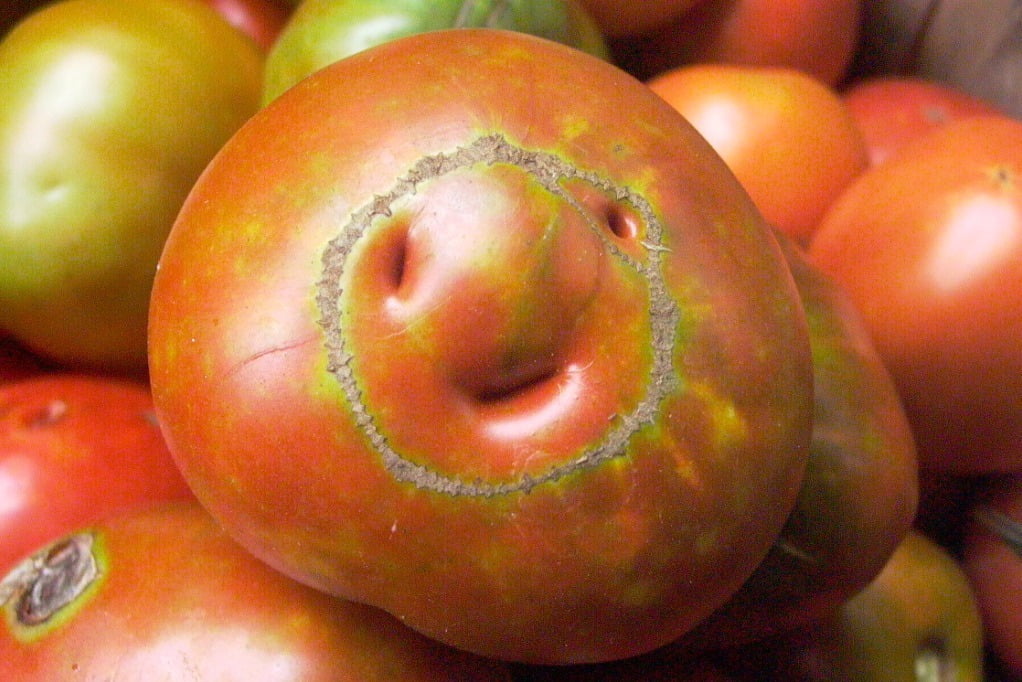
This year, we decreased the number of tomatoes we’re growing. We added more space between the varieties so there would be a more acceptable isolation between our favorites. The seedlings looked great. But now that they’re beginning to bear, we find that three Black Cherry tomatoes are planted in the middle of the block of Paul Robesons, our hands-down favorite black heirloom. Oops. Black Cherry is my favorite cherry tomato, but I don’t want to mix it with the Robesons! There was a hole in our organizational system. The cherries will have to go, and our gene pool will be smaller than we had intended. We have to take the losses as gains in understanding – opportunities for refinement.
In the meantime, Paul has extended his seed-saving reach to include summer squash. We’re growing three varieties of summer squashes in one row, all are cucurbita pepo (as opposed to c.moschata or c.maxima). Bees are busy in the flowers ALL the time, and they don’t discriminate between the Bennings Green Tint and Yellow Crookneck. Paul goes out early each morning, pollinates the newly opened flowers, and ties them shut with surveyor tape. His first try, he was gentle and only tied the tops of the petals together. On his next pass through the garden, he could see that the bees had scrambled through the cracks and gotten into the flowers anyway. He untied the tops, released the trapped bees, and tried again, tying a little tighter this time. The bees chewed through the flower petals, so on the third try, he wound the tape around the whole flower. With luck, we’ll get to plant a few of the seeds later this season to see if it worked.
Kale is a more straight-forward plant to save for seed, and we enjoy the process. Last year’s Fall greens were planted in late July. We’ve just pulled recently harvested them for seed. The dried stalks were cut and bundled on a nice sunny day. 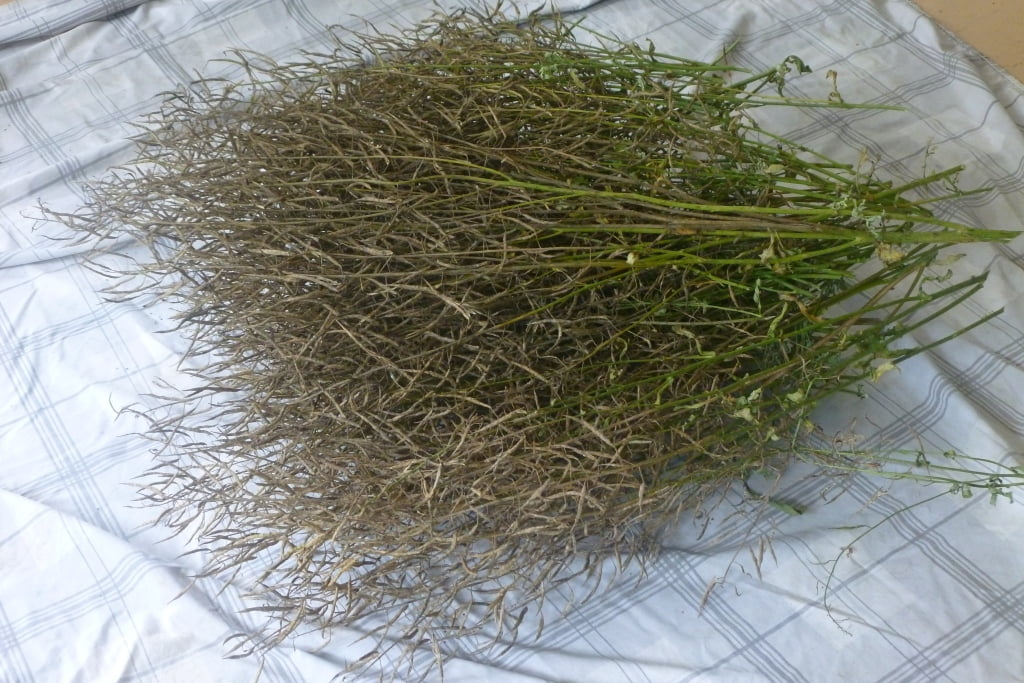
We wrapped them in an old sheet or tarp (with no holes in it) and did a seed stomping dance on the whole package. 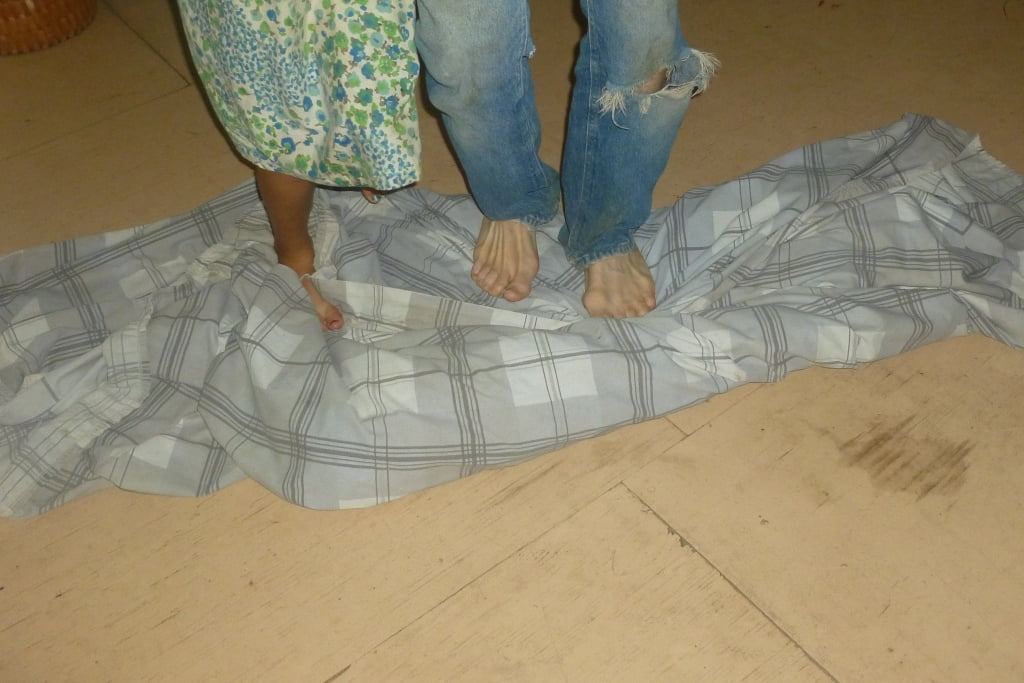
The round kale seeds dislodged from their stalks and roll to the bottom. We took out the big stalks and moved the seeds and chaff to a large bowl.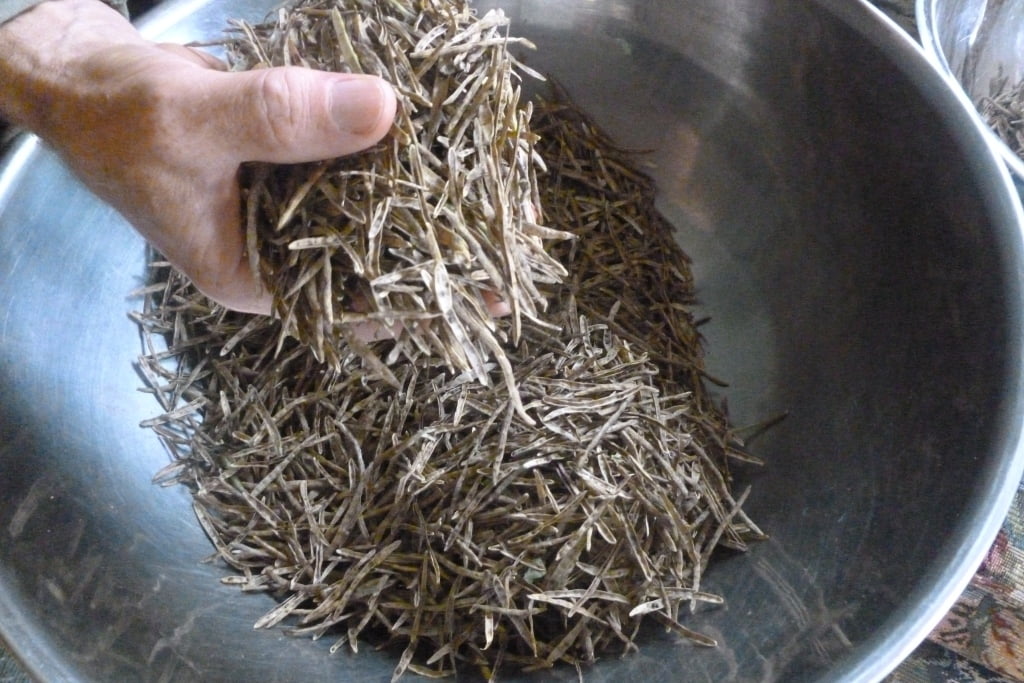
Paul carefully shakes out the pods, and runs the final mess through a few rounds of winnowing with a window fan. 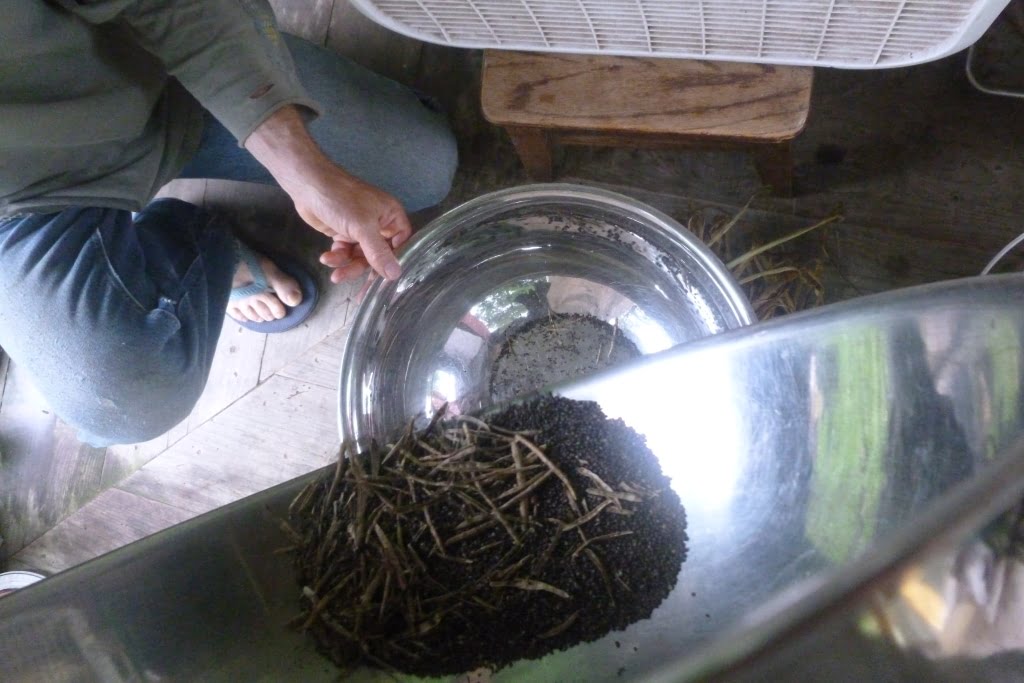 The result is a beautiful crop of kale seed, that will, with luck, provide a strong winter’s worth of greens for ourselves and many others.
The result is a beautiful crop of kale seed, that will, with luck, provide a strong winter’s worth of greens for ourselves and many others.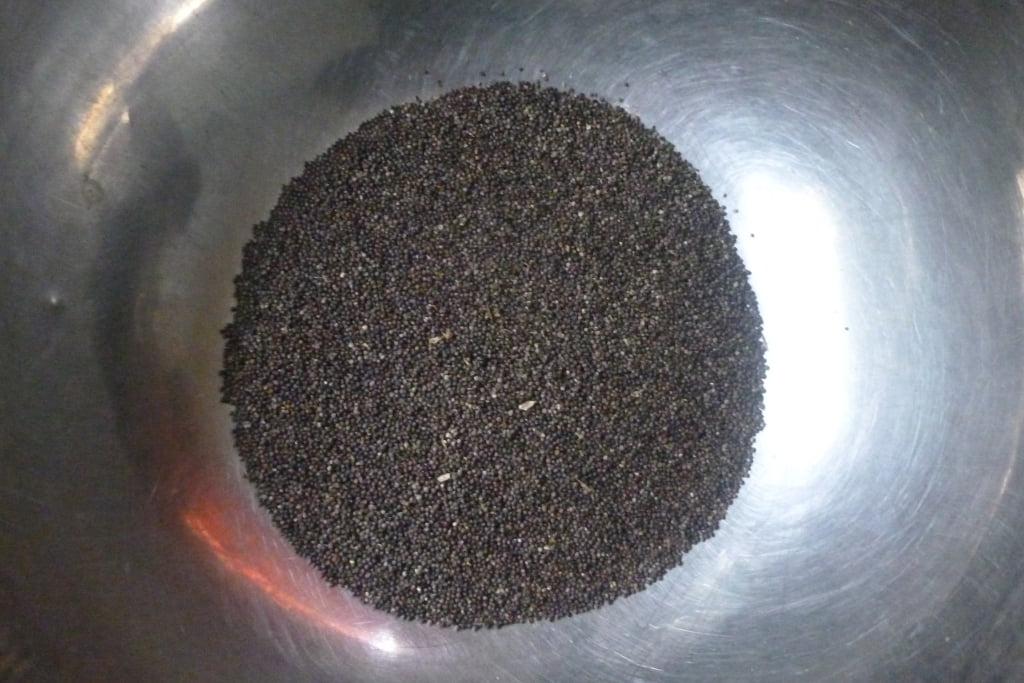
The kale has been a relatively easy crop to manage next to the rice. We’re big rice eaters here, and after studying on it for awhile, Paul decided there was no reason we shouldn’t try to grow some upland rice – the sort that doesn’t need a paddy. Just a couple rows. Three years ago we started some in blocks and threw them into the upper garden. It was a little late, but not a bad season. The rice grew very nicely, but never set seed. Hmmm. Next year we tried again, this time getting an earlier start and planting them in the lower garden, figuring rice liked more moisture. But that year was the drought. We were glad that it set seed at all, but the harvest was not abundant. After much effort, we came away with enough to re-plant a row this year. We ordered more seed and started early. So far so good. I’ll keep you posted.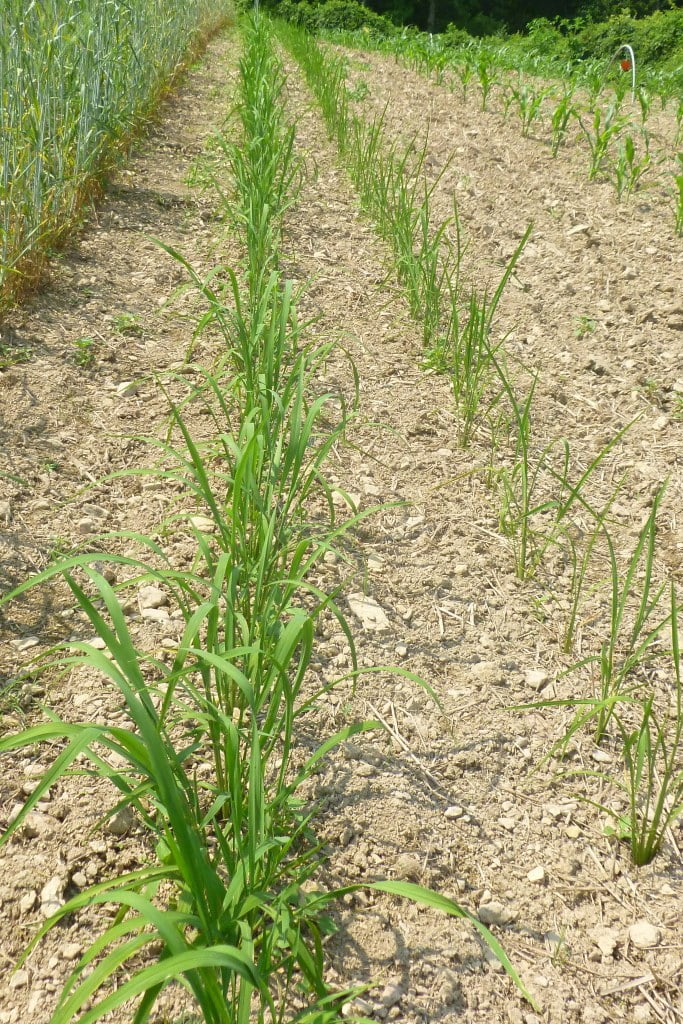
This work takes a certain amount of determination. We can’t be put off by the obstacles that arise. We just have to learn from them. There are times when we seem to be succeeding in our work, and then the weather turns abruptly and violently against our goals. There are times that we have not refined our system, but Mother Nature cooperates so well as to compensate for our failings. Even if this season goes perfectly and produces in great abundance, we can’t get cocky. The weather is as changeable as the human mind. Next year will have its own set of challenges that we may never have considered.
Yes, it is a tremendous effort. And there are no guarantees at success. In fact, there is a great probability of difficulty. So why do we do it? Surely there are other things we could be doing with our time. Seeds can’t be that expensive, right?
To put it simply, in Sanskrit:
Yoga Sutras I.2 – yogas citta vrtti nirodhah
I. 12 – abhyasa vairagyghyam tan nirodhah
I.13 – tatra sthitau yatno bhyasah
I.14 – sa tu dirgha kala nairantarya satkarasevito drdha bhumih
OR
“Yoga is the ability to direct the mind exclusively toward an object and sustain that direction without any distractions.”
“The mind can reach the state of Yoga through practice and detachment.”
“Practice is basically the correct effort required to move toward, reach and maintain the state of Yoga.”
(I really love this one.) “It is only when the correct practice is followed for a long time, without interruptions and with a quality of positive attitude and eagerness, that it can succeed.”
(referenced, gratefully, from the Yoga Sutra Workbook by Vyaas Houston, The Essence of Yoga, by Bernard Bouanchaud, The Heart of Yoga by T.K.V. Desikachar, and training with Gary Kraftsow)
Whatever the task, these are my guidelines. Our work right now is building soil, growing good food, viable seeds, and healthy children. All of those are works of duration and deep learning. Our efforts may not be immediately fruitful, but they aren’t wasted either. Considering this, we’ve got all the time in the world.